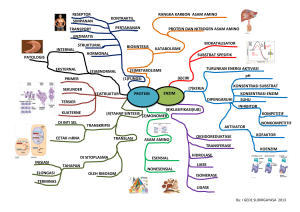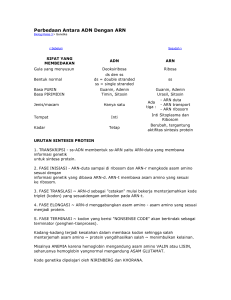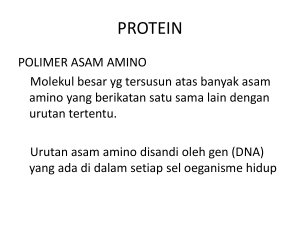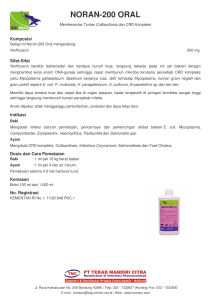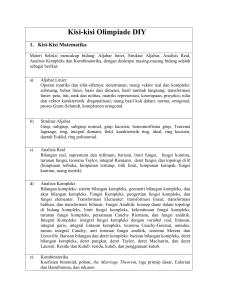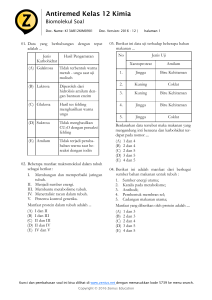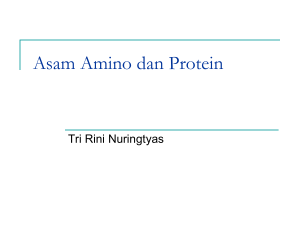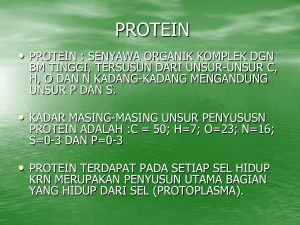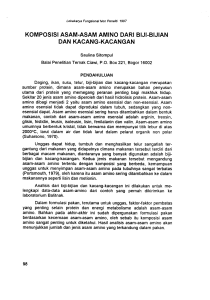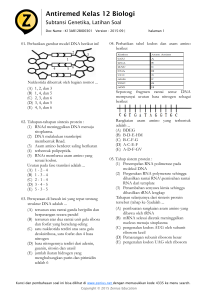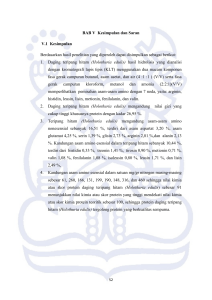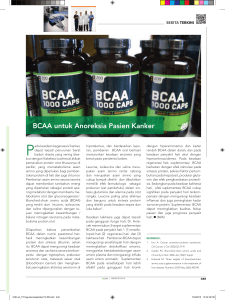ABSTRAK PEMODELAN INTERAKSI PROTEIN TIROSIN
advertisement
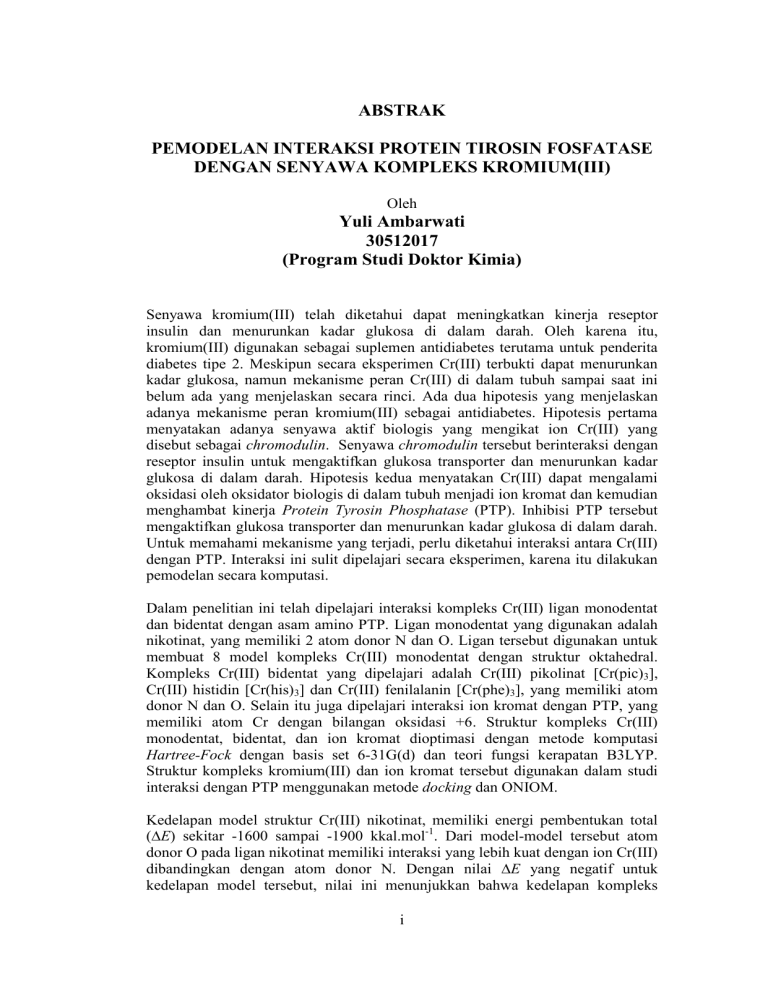
ABSTRAK PEMODELAN INTERAKSI PROTEIN TIROSIN FOSFATASE DENGAN SENYAWA KOMPLEKS KROMIUM(III) Oleh Yuli Ambarwati 30512017 (Program Studi Doktor Kimia) Senyawa kromium(III) telah diketahui dapat meningkatkan kinerja reseptor insulin dan menurunkan kadar glukosa di dalam darah. Oleh karena itu, kromium(III) digunakan sebagai suplemen antidiabetes terutama untuk penderita diabetes tipe 2. Meskipun secara eksperimen Cr(III) terbukti dapat menurunkan kadar glukosa, namun mekanisme peran Cr(III) di dalam tubuh sampai saat ini belum ada yang menjelaskan secara rinci. Ada dua hipotesis yang menjelaskan adanya mekanisme peran kromium(III) sebagai antidiabetes. Hipotesis pertama menyatakan adanya senyawa aktif biologis yang mengikat ion Cr(III) yang disebut sebagai chromodulin. Senyawa chromodulin tersebut berinteraksi dengan reseptor insulin untuk mengaktifkan glukosa transporter dan menurunkan kadar glukosa di dalam darah. Hipotesis kedua menyatakan Cr(III) dapat mengalami oksidasi oleh oksidator biologis di dalam tubuh menjadi ion kromat dan kemudian menghambat kinerja Protein Tyrosin Phosphatase (PTP). Inhibisi PTP tersebut mengaktifkan glukosa transporter dan menurunkan kadar glukosa di dalam darah. Untuk memahami mekanisme yang terjadi, perlu diketahui interaksi antara Cr(III) dengan PTP. Interaksi ini sulit dipelajari secara eksperimen, karena itu dilakukan pemodelan secara komputasi. Dalam penelitian ini telah dipelajari interaksi kompleks Cr(III) ligan monodentat dan bidentat dengan asam amino PTP. Ligan monodentat yang digunakan adalah nikotinat, yang memiliki 2 atom donor N dan O. Ligan tersebut digunakan untuk membuat 8 model kompleks Cr(III) monodentat dengan struktur oktahedral. Kompleks Cr(III) bidentat yang dipelajari adalah Cr(III) pikolinat [Cr(pic)3], Cr(III) histidin [Cr(his)3] dan Cr(III) fenilalanin [Cr(phe)3], yang memiliki atom donor N dan O. Selain itu juga dipelajari interaksi ion kromat dengan PTP, yang memiliki atom Cr dengan bilangan oksidasi +6. Struktur kompleks Cr(III) monodentat, bidentat, dan ion kromat dioptimasi dengan metode komputasi Hartree-Fock dengan basis set 6-31G(d) dan teori fungsi kerapatan B3LYP. Struktur kompleks kromium(III) dan ion kromat tersebut digunakan dalam studi interaksi dengan PTP menggunakan metode docking dan ONIOM. Kedelapan model struktur Cr(III) nikotinat, memiliki energi pembentukan total (∆E) sekitar -1600 sampai -1900 kkal.mol-1. Dari model-model tersebut atom donor O pada ligan nikotinat memiliki interaksi yang lebih kuat dengan ion Cr(III) dibandingkan dengan atom donor N. Dengan nilai ∆E yang negatif untuk kedelapan model tersebut, nilai ini menunjukkan bahwa kedelapan kompleks i tersebut dapat tersebut secara eksperimen. Kompleks Cr(III) nikotinat dengan perbandingan Cr dan nikotinat 1:1 [Cr(O-nic)(OH)2(H2O)3] merupakan kompleks yang memiliki energi pembentukan terendah yaitu ∆E = -1915,766 kkal.mol-1. Perhitungan docking terhadap kedelapan kompleks Cr(III) nikotinat, menunjukkan interaksi yang paling baik yaitu kompleks trans[Cr(O-nic)2(OH)(H2O)3] memiliki energi interaksi sebesar -6,500 kkal.mol-1. Kompleks tersebut berinteraksi dengan 6 asam amino PTP, yang mayoritas berada pada sisi aktif PTP, yaitu asam amino Leu(13), Glu(14), Cys(17), Arg(18), Trp(49) dan Asn(50). Hasil perhitungan ONIOM menunjukkan terbentuk 7 ikatan hidrogen dengan jarak 2,4 – 3,8 Å. Kompleks Cr(III) dengan ligan bidentat, [Cr(pic)3], [Cr(his)3] dan [Cr(phe)3] memiliki ∆E yang berdekatan yaitu sekitar -2700 kkal.mol-1. Berdasarkan nilai ∆E tersebut, ketiga kompleks memiliki struktur yang lebih stabil dibandingkan kompleks Cr(III) nikotinat. Perhitungan docking menunjukkan kompleks [Cr(his)3] memiliki interaksi yang paling kuat dibandingkan dengan [Cr(pic)3] dan [Cr(phe)3]. Kompleks [Cr(his)3] berinteraksi dengan 9 asam amino PTP, yaitu Cys(12), Gly(14), Ile(16), Cys(17), Arg(18), Trp(49), Asn(50), Asp(129), Tyr(131), sebagian besar asam amino tersebut berada pada sisi aktif PTP. Besar energi interaksi kompleks [Cr(his)3] dengan asam amino PTP adalah -7,400 kkal.mol-1. Hasil ONIOM menunjukkan bahwa interaksi [Cr(his)3] dengan asam amino PTP menghasilkan 8 ikatan hidrogen dengan jarak 2,0 – 3,6 Å. Ion kromat yang diduga sebagai inhibitor PTP, juga dipelajari interaksinya dengan asam amino PTP secara komputasi. Hasil docking menunjukkan energi interaksi sebesar -4,100 kkal.mol-1. Nilai tersebut relatif rendah dibandingkan dengan interaksi asam amino PTP dengan kompleks Cr(III) monodentat dan bidentat. Tetapi, ion kromat berinteraksi dengan kelima sam amino sisi aktif PTP yaitu Leu(13), Gly(14), Ile(16), Cys(17), Arg(18). Hasil ONIOM menunjukkan bahwa interaksi ion kromat dengan asam amino PTP menghasilkan 7 ikatan hidrogen dengan jarak ikatan sebesar 1,9 - 2,0 Å, jarak tersebut lebih pendek daripada interaksi kompleks Cr(III) dengan PTP. Hasil docking dan ONIOM menunjukkan bahwa interaksi kompleks kromium(III) dengan asam amino PTP sangat dipengaruhi jenis dan ukuran ligan. Hal ini merupakan hal penting dalam merancang suatu kompleks sebagai zat antidiabetes. Kata kunci: kromium(III) nikotinat, kromium(III) pikolinat, kromium(III) histidin, kromium(III) fenilalanin, ion kromat, Protein Tirosin Fosfatase, DFT, B3LYP, docking, ONIOM, ii ABSTRACT MODELING OF INTERACTION BETWEEN PROTEIN TYROSIN PHOSPHATASE AND CROMIUM(III) COMPLEXES By Yuli Ambarwati 30512017 (Doctoral Program in Chemistry) Chromium(III) compounds are recognized to increase insulin receptor activity and reduce glucose levels in the blood. Thus the result that chromium(III) is used as an antidiabetic supplement particularly for people with type 2 diabetes. However, although it has experimentally been exposed to decrease glucose levels, the role mechanism of Cr (III) in the body has not been explained in detail until now. There are two hypothesis that describe the role mechanism of chromium(III) as antidiabetic. The first hypothesis explains the presence of biological active compounds that bind Cr(III) ions called chromodulin. In this case, the chromodulin compound interacts with the insulin receptor to activate the glucose transporter and reduce glucose levels in the blood. The second hypothesis states that Cr(III) can be oxidized by biological oxidizing agent in the body to turn into chromate ions and then inhibit the performance of PTP. The PTP inhibition can active the glucose transporter and decreases glucose levels in the blood. To understand the mechanism, that occurs is to identify the interaction between Cr(III) and PTP. This interaction is difficult to study experimentally yet, it is computationally performed by modelling. In this research have studied the interaction of Cr (III) monodentate and bidentate ligand complexes with amino acid PTP. The monodentate ligand used is nicotinate, which has 2 donor atoms N and O, there are 8 models of Cr(III) with octahedral structures. The Cr(III) bidentate complexes are Cr(III) picolinate [Cr(pic)3], Cr(III) histidine [Cr(his)3] and Cr(III) phenylalanine [Cr(phe)3], which has N and O donor atoms. In addition, chromate ion interaction was studied which has Cr atom with +6 oxidation number. The optimization of the structure of complex compounds is done by computational method of Hartree-Fock with 6-31G(d) basis set and the B3LYP density function theory. While the interaction studies of Cr(III) complexes and chromate ions with PTP have been studied using docking and ONIOM methods. The eight models of Cr(III) nicotinic structure have total formation energy (ΔE) around -1600 to -1900 kcal.mol-1. Of these models the O donor atoms of the nicotinic ligand hasa stronger interaction with Cr(III) ions than N donor atoms. iii The Cr(III) nicotinic complex by comparison Cr and nicotinate 1: 1 [Cr(O-nic)(OH)2(H2O)3] is the complex that has the lowest formation energy ie ΔE = -1915,766 kcal.mol-1. The docking calculation of the Cr(III) nicotinic complexes, showing the best interaction of the trans [Cr(O-nic)2(OH)(H2O)3] complex has an interaction energy of -6,500 kcal.mol-1. The complex interacts with 6 amino acids PTP, most of which are on the active side of PTP, ie the amino acid Leu(13), Glu(14), Cys(17), Arg(18), Trp(49) and Asn(50). The ONIOM calculation results in 7 hydrogen bonds with a distance of 2.4 - 3.8 Å. The Cr(III) complex with bidentate ligand, [Cr(pic)3], [Cr(his)3] and [Cr(phe)3] have adjacent ΔE of about -2700 kcal.mol-1. Based on the ΔE values, the three complexes have a more stable structure than the Cr (III) nicotinic complexes. The docking calculation show the [Cr(his)3] complex has the best interaction compared to [Cr(pic)3] and [Cr(phe)3]. The [Cr(his)3] complex interacts with 9 amino acids PTP, ie Cys(12), Gly(14), Ile(16), Cys(17), Arg(18), Trp(49), Asn(50), Asp(129), Tyr(131), most of the amino acids are on the active side of the PTP. The interaction energy of [Cr(his)3] complex with amino acids PTP is -7,400 kkal.mol-1. The ONIOM results show that the interaction of [Cr(his)3] with the amino acid PTP yields 8 hydrogen bonds with a distance of 2.0 - 3.6 Å The chromate ions suspected as PTP inhibitors, were also studied interactions with amino acids PTP in computationally. The docking result shows the interaction energy of -4,100 kcal.mol-1. This value is relatively low compared to the interaction of amino acid PTP with Cr(III) monodentate and bidentat complexes. However, chromate ions interact with the five amino acids of the active PTP side, ie Leu(13), Gly(14), Ile(16), Cys(17), Arg(18). The ONIOM results indicate that the interaction of chromate ions with the amino acid PTP produces 7 hydrogen bonds with a bond distance of 1.9 to 2.0 Å, the distance being shorter than the Cr (III) complex interaction with PTP. Keywords: Nicotinic acid chromium (III), picolinate chromium (III), histidine chromium (III), phenylalanine chromium (III), chromic ion, tyrosine phosphatise, DFT, B3LYP, docking, ONIOM, iv
